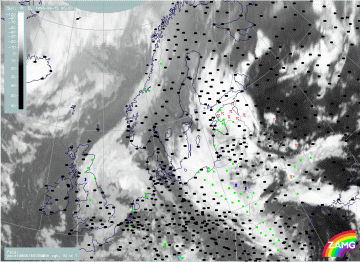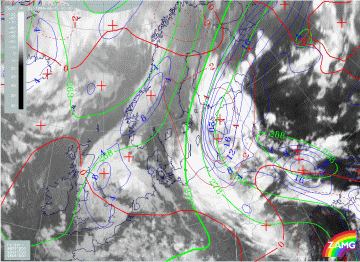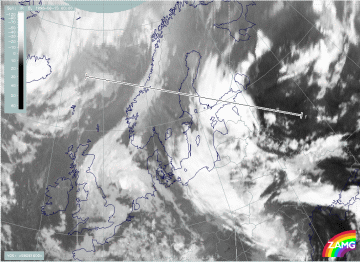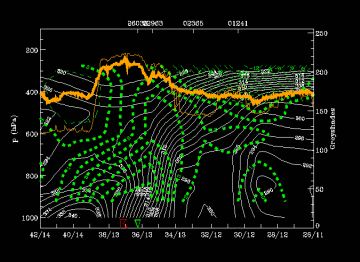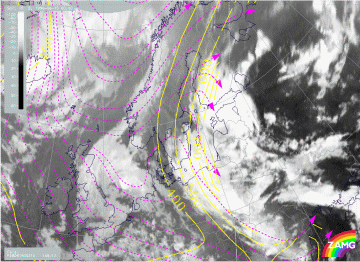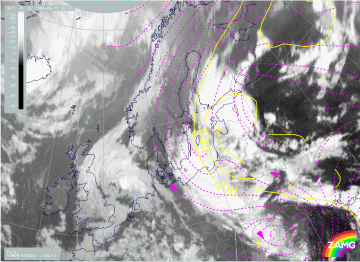15 June/00.00 UTC: Frontal diagnosis
Satellite Overview
On 15 June a northward penetration of cloudiness takes place over Finland (Fig. H47). A double structure has developed at the Warm Front system; one part over Poland, Baltic Sea and Sweden, the other over the Baltic States and Finland. The old CCB Occlusion is still well developed. The connection from the Warm Front to the Cold Front is rather unorganized as seen in the cloud structures over the Baltic States and White Russia. The Cold Front becomes more organized over the area from the Ukraine to the Black Sea. There are many thunderstorms observed over Estonia. Notably, there is no precipitation in the downstream parts of the two cloud shields.
|
15 June 1998/00.00 UTC - Meteosat IR image; weather events (green: rain and showers, blue: drizzle, cyan: snow, red: thunderstorm with
precipitation, purple: freezing rain, orange: hail, black: no actual precipitation or thunderstorm with precipitation)
|
|
Parameters on isobaric surfaces
Compared to earlier water vapour images, there has been westward movement of the dark WV band in Fig. H48. A sharp boundary between tropospheric and stratospheric air is evident over Sweden. The eastward shift of zero line of shear vorticity at 300 hPa could again be a model error.
|
15 June 1998/00.00 UTC - Meteosat WV image; red: height of PV=2 units, black: shear vorticity 300 hPa
|
|
In Fig. H49 the surface low is still associated with the rather chaotic cloud structures of the Cold and Warm Front bands. The double structure of the Warm Front Band results from two different parts of the upper level stream, caused by the Upper Level Low over Romania.
|
15 June 1998/00.00 UTC - Meteosat IR image; red: height contours 1000 hPa, green: height contours 500 hPa
|
|
The Warm Front Band stretching from the Baltic States to Finland shows distinct frontal character in every aspect: thickness gradient, TFP and WA (Fig. H50). The cloud structures from Poland to Sweden belong more to the upper level stream and are without a distinct front character.
|
15 June 1998/00.00 UTC - Meteosat IR image; blue: thermal front parameter (TFP) 500/850 hPa, green: equivalent thickness 500/850 hPa,
red: temperature advection - CA 1000 hPa
|
|
Vertical Cross Sections
The vertical cross section line is perpendicular to the Warm Front over Finland and the Baroclinic Boundary over Norway. The orientation crosses the Warm Front from east to west (Fig. H51).
|
15 June 1998/00.00 UTC - Meteosat IR image; position of vertical cross section indicated
|
|
Isentropes and satellite pixel values:
Very distinct Warm Front Band with very unstable air within and in the rear can be seen in Fig. H52. Broad IR and WV pixel value peaks are associated with both systems. The second IR peak is situated around station 01241 in front of the very steep zone of high gradient of isentropes. It corresponds to the Norwegian Baroclinic Boundary.
Temperature advection:
There is distinct WA within the WF zone from the surface up to 300 hPa (Fig. H52). There is also WA in the unstable area in front of it up to 650 hPa with CA above - a typical distribution for instability. There is only very weak WA over Norway associated with the Baroclinic Boundary.
|
15 June 1998/00.00 UTC - Vertical cross section; white: isentropes (ThetaE), green thin: temperature advection - CA, green thick:
temperature advection - WA, orange thin: IR pixel values, orange thick: WV pixel values
|
|
Convergence:
In fig. H53 no distinct convergence associated with the WF can be seen, but there is some convergence in the region of the Baroclinic Boundary over Norway between approx. 900 - 600 hPa. The Warm Front Band characteristics are still clear to see.
|
15 June 1998/00.00 UTC - Vertical cross section; white: isentropes (ThetaE), green thin: divergence, green thick: convergence, orange
thin: IR pixel values, orange thick: WV pixel values
|
|
With help of parameters on isentropic surfaces: Air mass separation
Selection of characteristic isentropic surfaces (Fig. H54):
- 312K: is within the Warm Front zone
- 324K: is partly directly on top of the Warm Front zone and partly further above, thus only relevant west of the unstable air mass.
|
15 June 1998/00.00 UTC - Vertical cross section; white: isentropes (ThetaE), green: relative humidity, orange thin: IR pixel values,
orange thick: WV pixel values
|
|
The 312K image shows a downward inclination of isobars from 400 to 800 hPa and a strong sinking of the relative streams from the west (Fig. H55).
|
15 June 1998/00.00 UTC - Meteosat IR image; magenta: relative streams 312K, yellow: isobars
|
|
The 324K image shows a rising Warm Conveyor Belt in the relative streams from the Baltic States over Finland (Fig. H56).
|
15 June 1998/00.00 UTC - Meteosat IR image; magenta: relative streams 324K, yellow: isobars
|
|
Looking at the potential vorticity (Fig. H57) the moist tropospheric air in the the WV band lies below 300 hPa. The distinct gradient in the area of the Dark Stripe forms the boundary with stratospheric air above 300 hPa. As was the case 6 hours earlier, stratospheric air has descended below 300 hPa in the area of the Upper Level Low and to the rear of the Cold Front over the Black Sea.
|
15 June 1998/00.00 UTC - Meteosat WV image; cyan: height of PV=2 units 324K, red: isobars 324K
|
|
